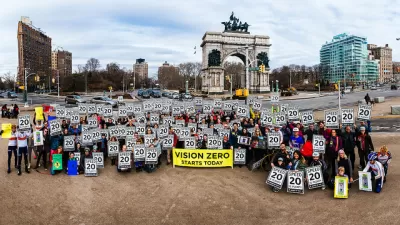The technology to make traffic enforcement obsolete is becoming available. But in the U.S. willing to use it?

A new document from the National Highway Traffic Safety Administration quietly asks the public its opinion on a radical change. In a new federal rule making on vehicle safety, it asks: should we explore requiring speed limiting technology in U.S. cars?
In the most tentative way, the agency is introducing a discussion about what will this year become law in the European Union: Intelligent Speed Assistance (ISA). ISA—or speed governors—is technology that automatically limits drivers to, or around, the posted speed limit using GPS technology (except in rare circumstances when it needs to be overridden for safety reasons).
As fantastical as it seems, it’s relatively uncontroversial in a lot of our peer nations. And road ready as well. In July, it will become mandatory on all new vehicles in Europe.
In the United States, where traffic deaths rates are many times that of Europe, federal regulators are signaling that adoption is a vaguely distant future possibility. (It’s proposed for consideration over a ten-year timetable.)
“Should NHTSA take into consideration systems, such as intelligent speed assist systems, which determine current speed limits and warn the driver or adjust the maximum traveling speed accordingly?” the agency asks tentatively, inviting feedback from the public.
Part of the reason for the hesitancy is certainly cultural. Speeding is such a taken-for-granted part of American driving—almost an entitlement. We seem to have forgotten how dangerous it is. But that doesn’t mean the bodies have stopped piling up.
According to the Centers for Disease Control (CDC), in an average year in the United States about 10,000 people are killed in speeding related crashes. And during the pandemic, thanks to a surge of reckless driving, it’s gotten worse. With fatality numbers up 19 percent over just two years, on a miles-driven basis.
There may be another contributing factor to increasing road carnage that is more thorny: A decline in traffic enforcement following the Black Lives Matter protests of last summer. Cities have ample reason to rethink traffic stops, which are frequently biased and often escalate into tragic and costly shootings.
But not enforcing dangerous driving seems to have its downside as well. Part of the explanation for rising road fatalities might be a side effect.
Which is why it’s disappointing there isn’t more enthusiasm from federal regulators right now about a technology that could replace traffic enforcement while tamping down bad behavior on the roads and the attending carnage.
The availability of ISA comes at opportune time. It’s not just speeding that could be all but eliminated technologically. An obscure passage in the Infrastructure Investment and Jobs Act will require, for the first time, automakers to install anti drunk driving technology standard in all new cars. These systems can detect when a driver is intoxicated and disable the vehicle. (Drunk driving causes about 10,000 deaths a year in the United States as well, the CDC estimates.)
Technology is also becoming available that uses the same sort of advanced technology to detect distraction and “nudge” drivers eyes back to the road and hands back to the steering wheel—similar to the “beep, beep, beep” system we’ve used to quietly self-enforce seat belt use.
It must be noted that none of this technology would solve the problem overnight. It takes about 11 years for the vehicle fleet in the United States to turn over—to replace all the old cars with new cars.
But if we had the will to install these life-saving technologies, we could start to see improvements immediately. And the 11-year replacement period would give us a chance to transition the million-some people whose job it is to enforce traffic rules into different roles.
In the past, the United States has been resistant—for political reasons—to using speed limiting technology, even in commercial trucks. But the time has come to rethink traffic enforcement and vehicle safety technology. The longer we wait, the farther we will fall behind and the more people will get killed.

Alabama: Trump Terminates Settlements for Black Communities Harmed By Raw Sewage
Trump deemed the landmark civil rights agreement “illegal DEI and environmental justice policy.”

Planetizen Federal Action Tracker
A weekly monitor of how Trump’s orders and actions are impacting planners and planning in America.

Why Should We Subsidize Public Transportation?
Many public transit agencies face financial stress due to rising costs, declining fare revenue, and declining subsidies. Transit advocates must provide a strong business case for increasing public transit funding.

Understanding Road Diets
An explainer from Momentum highlights the advantages of reducing vehicle lanes in favor of more bike, transit, and pedestrian infrastructure.

New California Law Regulates Warehouse Pollution
A new law tightens building and emissions regulations for large distribution warehouses to mitigate air pollution and traffic in surrounding communities.

Phoenix Announces Opening Date for Light Rail Extension
The South Central extension will connect South Phoenix to downtown and other major hubs starting on June 7.
Urban Design for Planners 1: Software Tools
This six-course series explores essential urban design concepts using open source software and equips planners with the tools they need to participate fully in the urban design process.
Planning for Universal Design
Learn the tools for implementing Universal Design in planning regulations.
Caltrans
Smith Gee Studio
Institute for Housing and Urban Development Studies (IHS)
City of Grandview
Harvard GSD Executive Education
Toledo-Lucas County Plan Commissions
Salt Lake City
NYU Wagner Graduate School of Public Service





























